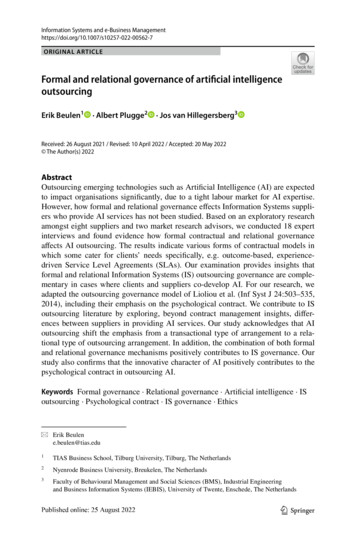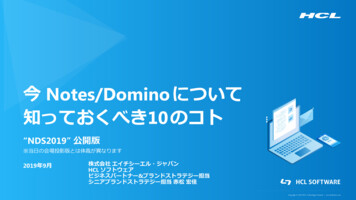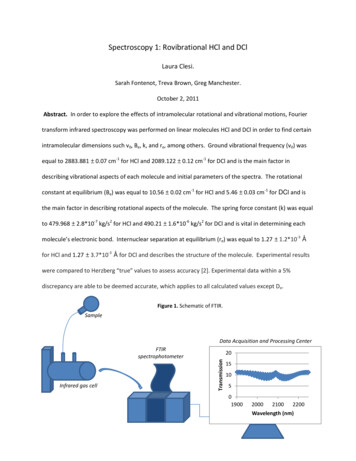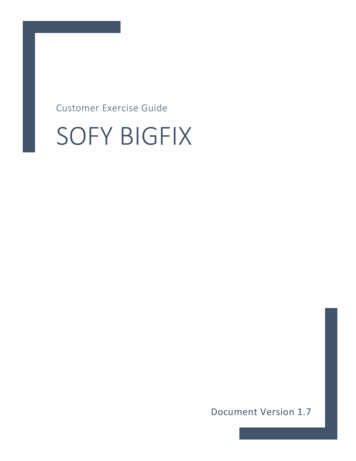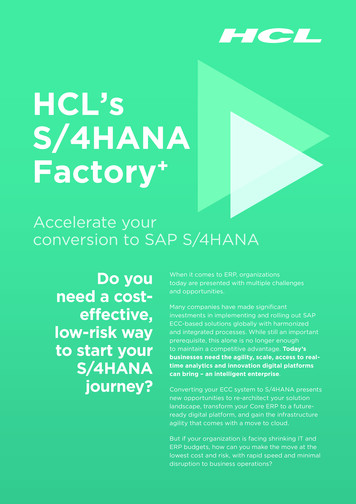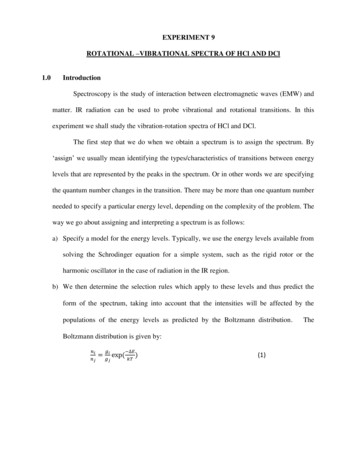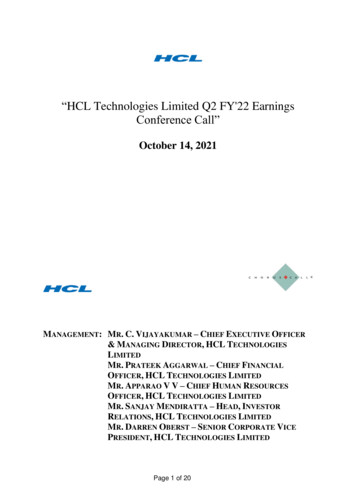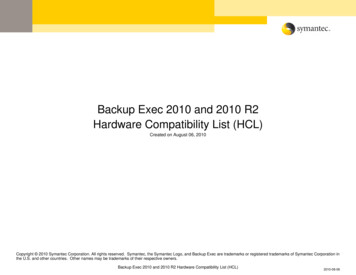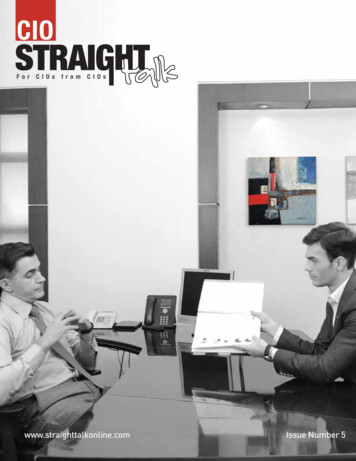
Transcription
www.straighttalkonline.comIssue Number 5
MAKINGENTERPRISEMOBILITYA REALITYInnovative mobility initiatives at Walmart,Merck, Qatar Airways, Dr PepperSnapple, and other forward-lookingcompanies.PAGE 06www.straighttalkonline.comIssue Number 5
ContentCover ArticleMaking EnterpriseMOBILITY A REALITY05Innovative mobility initiatives at Walmart, Merck, Qatar Airways, Dr Pepper Snapple,and Montreal TransitStraight Talking1723The ROI of Hard WorkRunning IT Like a Business . . .at a Giant NonprofitKristin Russell, former Secretary ofTechnology and CIO, State of Colorado27Seven Habits of the HighlySuccessful CIOBrian Adams, CIO and Director ofProcurement, WorleyParsons37Terry Bradwell, EVP and CIO, AARP33Seven Essentials of the HighlySuccessful IT FunctionTurkka Keskinen, CIO, UPM41Reimagining ITEmerging Technology,Emerging MarketsRichard Seltz, CIO and VP,Information Technology, ChemturaVivek Vasudev Kamath, ExecutiveDirector, MSD (Merck) India
Issue Number 54549Culture Change: IT as anInnovation EngineShifting GearsAnnabelle Bexiga, EVP and CIO,TIAA-CREFTimothy Heffron, Vice President,Human Resources, and CIO, MeritorBig ThinkingSolution SpotlightTackling Two BigIT Challenges6252The CIO Role in theEnterprise of the FutureAndrew McAfee, cofounder,Initiative on the Digital Economy,MIT Sloan School of ManagementReborn Digital: Reinventingthe Enterprise for the Digital AgeSteven Cardell, President, EnterpriseServices and Diversified Industries,HCL Technologies64Proactive Obsolescence:Turning ASM Costs intoChange-the-BusinessInvestmentsMark Hirst, Global Head, PublicServices, HCL Technologies57Failure Can WireYour Brain for InnovationMichele Gallen, CEO, Shhmooze
CIO Straight Talk TeamEditor Paul HempManaging Editor Ritesh GargContributing Editors Stephanie Overby, GlennRifkin, Alan EarlsCopy Editor Amy HallidayArt Director Neha SharmaDigital and Social Anirban SanyalEvents and Webcasts Mishtun ChatterjeeDistribution and Leverage Atul SharmaEditorial Advisory Board Anant Gupta, KrishnanChatterjee, Apurva Chamaria, Amar Singh, HarshKumar, Anirban SanyalPrinting Quality Printing, Pittsfield, MA, USALustra Print Process Pvt. Ltd., New DelhiAcknowledgementsAbhishek JM, Abhishek Singh, Arun Menon, BhaskarVedula Rao, Biswajit Rath, Utkarsh Srivastav, SanjeevKaul, Gangeya Purushottam, Gaurav Kapahi, GauravKumar, Hitesh Parekh, John Meyer, Krishna Kotipalli,Marc Chesover, Nikhil Chakravarthy Manupati, NeerajSingh, Paresh Vankar, Pichumani Sathyanarayana,Sudha Balasubramanyan, Shoba Pfaff, ShimonaChadha, Shirish Sahay, Siva Charvu, Vikas Goel, VinayJ. Mathew, Yasser Ahmed Khan.Contact UsFor information on reprinting articles and all othercorrespondence, please contact:Atul SharmaHCL Technologies1st Floor, A-2, Sector – 3Noida – 201301,Uttar Pradesh, Indiasharma.atulsh@hcl.comWendy Semerau1 Mid America Plaza, Suite 403Oakbrook Terrace, IL 60181USA408-328-7701wsemerau@hcl.comCIO Straight Talk is a periodical published by HCL Technologies (HCLT) meant for its existing and prospective clients forinformation purposes. The information contained in thepublication contains general views based on the experiencesof technology practitioners and subject matter experts withinand outside of HCLT, expressed by them in their individualcapacity and in no event shall HCLT (including its affiliatesand group companies) be liable for any claim, damages orany other liability arising out of or resulting from thispublication. You are advised to seek professional advicebefore making any decision that may affect your business.All contents are copyright 2014 by HCL Technologies Ltd.All rights reserved. Excerpts may be reprinted with attribution to HCL Technologies.The Wisdom of Your PeersWe recently launched a sister publication to CIOStraight Talk, called CTO Straight Talk. Like themagazine you are reading now, CTO Straight Talkhighlights the thinking of those working in the field —in that case, CTOs and other senior productengineering executives. As we put together the firstissue, I was struck again by the value of our content,value that flows from our decision to showcase“practitioner thought leadership” in these two StraightTalk publications.The inaugural issue of CTO Straight cludes a cover article (“The Internet of Experiences”)that offers a new take on the Internet of Things. Theissue also includes an interview with Tim Brown, theCEO of IDEO, on how design thinking can enhance theexperiences and “things” of the Internet of Things.But the heart of the first issue is a series of articlesby product engineering executives from Fortune 1000companies. Each one offers insights that could only bedistilled from the professional experiences ofexecutives like these.Which brings us to this issue of CIO Straight Talk,also packed with practitioner insights. For the coverarticle, we talked to CIOs and mobility heads at sixcompanies, ranging from Walmart to Qatar Airways,about initiatives they’ve launched to turn the promiseof enterprise mobility into a reality.The “Straight Talking” section features articles byCIOs offering a wide variety of views on an equallywide variety of topics — from “seven habits of thehighly successful CIO” to tackling an IT problem oftremendous complexity and massive scale. Theauthors’ organizations are in industries as different asfinancial services and automotive; they includenonprofits and government; and they are based in theU.S., Finland, India, and Australia.We hope the issue inspires you to share yourprofessional insights with peers on the CIO StraightTalk group on LinkedIn (http://lnkd.in/CIO StraightTalk). I’m confident they will find your ideas useful,just as we hope you will benefit from the peer insightsyou’ll find in this issue.Paul HempEditor
Cover Article
MAKINGENTERPRISEMOBILITYA REALITYFor all the hype surrounding enterprise mobility — thedeclarations of both its benefits and its risks — mostcompanies are still in the early stages of implementingmobile strategies. Here are the stories of five companiesthat are turning talk into action.7 CIO Straight Talk
Tectonic shifts in the technology landscape are nothingnew to CIOs. If you’re not ready for familiar strategiclandmarks to disappear every few years — if you’reuncomfortable with the maps used to plot your IT strategybecoming irrelevant — you’re in the wrong business.Take the emergence of mobile computing. Theconfluence of laptops, smartphones, tablets, cloudservices, and high-speed broadband 3G and 4G networksover the past decade is changing the very nature ofbusiness. Outside the organization, mobile computing istransforming how companies interact with customers andprospects. Within the organization, it is allowingcompanies to work smarter and faster — while raisingsecurity risks and weakening the CIO’s control of acompany’s technology framework.For example, the so-called consumerization of IT andthe BYOD phenomenon — you “bring your own device” touse at work, and with it heightened expectations forcomputing convenience and capabilities — represent amassive cultural reshaping of a company’s technologicalenvironment. CIOs who spent their careers overseeing amonopoly in corporate IT now face competition from endusers who have already experienced the benefits ofstate-of-the-art mobile consumer devices. In fact, enterprisemobility initiatives are often driven by senior executiveswith iPads who are insisting on the same dexterity with theircorporate data that they have with their personal data.The magnitude of the changes wrought by mobilecomputing is evident in analysts’ estimates, predictions,and assessments: Mobile devices now outnumber human beings, with anestimated 7.3 billion mobile devices in the world in 2012and just under 7 billion people, according to ForresterResearch.Dr Pepper Snapple: A MobilitySlingshot to Battle the GiantsWhen your chief rivals are Coke and Pepsi, you need allthe competitive weapons you can get.For Tom Farrah, CIO of Dr Pepper Snapple Group,one such weapon is enterprise mobility. In the beverageand consumer packaged goods industry, visibility andshelf space are crucial to success. DPSG’s decision toprovide its 2,400 account managers with iPads —equipped with real-time account information,promotional material, and critical sales data for everycustomer — is transforming how the company competeswith rivals and is already helping to increase sales.In just over a year, mobile technology at Dr PepperSnapple has shifted much of the complexity of doingbusiness from the customer-facing front end to the8 CIO Straight Talk Mobility is converging with social, cloud, and bigdata forces into a “nexus that is driving disruptivechanges to IT, businesses, and society overall,”according to Gartner. The global enterprise mobility market will reach 140billion by 2020, growing at an annual rate of 15%,according to HCL Technologies. The number of smartphones in use is about to surpassthe number of PCs in use, according to technologyanalyst Benedict Evans. In 2013, 56% of companies created organization-widemobile strategies and 47% increased investments inmobile and wireless capabilities, according to IDC.But being aware of and comfortable with theseismic transformations brought on by mobilecomputing isn’t the same as staying ahead of them. Forall the hype surrounding mobility these days, mostcompanies’ initiatives are in the nascent stage, and theCIO’s role in them isn’t always clear. Dan Bieler, ananalyst with Forrester Research, has written, “CIOs willbe responsible for introducing technology solutionsthat help break down silos, boost cross-teamcollaboration, drive the end-to-end customerexperience, and engage more deeply with customers. Inorder to succeed, CIOs must go beyond technologyenablement and support organizational and culturaltransformation.”Given that the devil is in the details, CIO StraightTalk reached out to a cross-section of organizations thatare in the midst of enterprise mobility efforts. Theirstories offer examples of mobility initiatives that arealready resulting in significant improvements incompanies’ internal processes and productivity, as wellas in their relationships with external customers.technology-enabling back end. Gone are the outdatedprint-laden binders that an account manager had to luginto every retail outlet he visited, replaced by sleek newiPads loaded with custom-made apps for solidifying thecrucial relationship with store managers.In a brand-based marketplace, Dr Pepper has longbeen a major force. The beverage, created in 1885 by aWaco, Texas pharmacist, is the oldest soft drink in theUnited States. Part of the Cadbury Schweppes empirefrom 1995 until 2008, the Dr Pepper Snapple beveragegroup was spun off into a stand-alone, publicly tradedcompany. The 6 billion business, which owns morethan 50 iconic trademarks, including Dr Pepper,Snapple, Mott’s, Schweppes, and 7 Up, is sold throughretailers around the world, from Walmart tomom-and-pop convenience stores.The company is heavily dependent on a very mobilesales force that is responsible for direct store delivery.
Account managers spend their days visitingindividual customers to take replenishment orders andsell incremental activities such as promotions, displays,and other sales-generating offerings. Given thereal-time, data-intensive nature of the business, theseaccount managers have long been prime candidates formobile technology. And until 2013, they (and the deliverydrivers) did indeed carry rugged Motorola handhelddevices. These devices, still used by delivery companieslike Fedex and UPS, work well enough for replenishmentorder taking: An order, input at the retail location,triggers a delivery over the next 24 to 48 hours.But Farrah, a Cadbury veteran, had more ambitiousplans. Providing retailers with information aboutincremental promotional activities turns out to be acomplex task. Typically, the account manager carriedaround printed material with information on allpromotions, ads, and sales activities for the month.Given that DPSG has 150 sales regions around the U.S.(each of which includes dozens if not hundreds ofretailers) and that the company comprises more than 50individual brands (each with its own pricing changes,special promotions, and point-of-sale materials), thetask of keeping updated binders with accurateinformation readily available for each account managerhad become a black hole.“You have account teams selling to Walmart orTarget or Kroger,” Farrah says. “You have mom-and-popstores all over the place. Every brand has its own“The last thing they want to do is say,‘Let me walk you through thispromotion,’ then hit a button and standthere waiting for it to download. Whenthey synchronize their device in themorning, it is all downloaded then andthere, so even if they are in a locationwithout cellular service, it doesn’tmatter.”Tom Farrah, CIO, Dr Pepper Snapple Groupmarketing activity, and every retail customer has its ownaccount team creating different promotions andactivities. When you take all the factors into account forour company — all the brands and how we license withour bottlers — there are over 12 million possiblecombinations of brand, bottler, and customer that needto be communicated to and executed at the store level.”Farrah saw that the sales binders — with their dirty,torn pages and often out-of-date information — had togo. “We decided to rebuild that application on an iPad,”Farrah says. “We started by moving the order entryapplication from the rugged handheld device to the iPad.Just by redesigning that application, we learned how totake advantage of the iPad interface, and we focused onthe user experience down to the nth detail.” Theapplication, built internally in IT, synchronizes all newdata automatically to the mobile device. Any newcustomers, products, pricing changes, or otherinformation is available in less than a minute with atouch of the screen before salespeople set out on theirroutes in the morning.The pilot program, launched in the first quarter of2013, was an immediate hit; salespeople reported that itcut their order-replenishment time in half.Phase two of the pilot was to get all the additionalpromotional material on the iPad. Now, when an accountmanager checks his route for the day, he sees a list of thatday’s customers. When he clicks on a mer-specific promotional activity, includingpricing, packaging, point-of-sales materials, and thepromotion timeline.“These guys usually have about two or three minutesof a store manager’s time,” Farrah says. “The last thingthey want to do is say, ‘Let me walk you through thispromotion,’ then hit a button and stand there waiting forit to download. When they synchronize their device inthe morning, it is all downloaded then and there, so evenif they are in a location without cellular service, it doesn’tmatter.”The most daunting task for IT, Farrah notes, wasbuilding the back-end engine that could gather anddistribute all that material. Using the company’s internalportal, Splashnet, Farrah’s team created MySplashnet,an intelligent personal portal for each individual in theorganization. When an account manager opensMySplashnet, it knows who and where he is and providesall his daily operational metrics.Having rolled all this out far more quickly thananticipated, Farrah wasn’t done. Each account manageralso has mobile BI (business intelligence) that ispersonalized to his account. He can click on My Routeand see, through a mapping device, each store he willvisit that day. Each store’s icon is accompanied by aballoon that opens to a box showing every brand andpackage that DPSG sells to that retailer, along withcurrent sales, month-to-date, year-to-date, and what theaverage is and ought to be. If a salesperson is behind forthe month, it tells him how many cases he needs to sell. Italso ranks the salespeople in that region so he knowswhere he stands.9 CIO Straight Talk
Though sales force mobility capabilities arebecoming standard operating procedure in the industry,Farrah believes that DPSG, in providing tailored data toindividual account managers, is ahead of rivals such asCoke and Pepsi.His objective for 2013 was to increase sales for thebusiness, and although he can’t attribute specific salesincreases to the mobility rollout, given the variety offactors involved, the anecdotal evidence has beengratifying. For example, the president of Farrah’sbusiness unit told him, “I’m not worried aboutcalculating the value that’s come out of this, because I seewhat’s going on in my business — and there’s no questionit is helping us to grow sales.”That’s feedback from the business side that any CIOwould welcome.Merck: Go Fast, Be AmbitiousWhen Merck, the 44 billion pharmaceutical giant,embarked on its enterprise mobility journey four yearsago, it took an unusual route. Many companies wereinitiating their mobile efforts with the sales force so thatsalespeople could access information in the field. Butaccording to Randie Schlamowitz, executive director ofMerck IT, Merck decided to emphasize the “enterprise”in enterprise mobility and enable its entire corporateenvironment holistically.“We built a company-wide mobile network,” sheexplains. “We made sure we had security in place andthat data was protected on mobile devices. We brought ina mobile device management tool, and we were able totrack company-purchased mobile phones and, over time,personal devices, too. We supported e-mail and calendarand all the standard productivity capabilities.”From there, Schlamowitz began to consider Merck’sSAP-based ERP environment as a fertile landscape fortaking mobility further. She began with a small pilotprogram. In a company the size of Merck, where manyfactors — performance, usability, support, etc. — need tobe considered, pilots are essential. The initial pilotenabled the approval of an expense report using aBlackberry or an iPhone. After the success of that effort,the pilot was then expanded to more than 1,000managers across the company. It wasn’t earth-shaking,but it was a start. “Our philosophy for enterprise mobileapplications is that we build them pretty rapidly — inanywhere from eight to twelve weeks — and deploy themamong a small pilot user group,” Schlamowitz says. “Weget feedback to ensure that there are no issues before wedeploy the app to a broader user base.”After its initial forays, the company began to get moreambitious. What would it take to enhance productivityfor managers, for the sales force, and for others aroundthe organization? Schlamowitz’s group investigatedavailable mobile enterprise application platforms, orMEAPs, and selected an SAP technology that pluggedseamlessly into the company’s SAP landscape. Her teamused this technology to rapidly enable certain key10 CIO Straight Talktransactions on mobile devices, primarily iPhones andiPads, as the Blackberry, the company’s traditionalsmartphone of choice, was eclipsed by rivals.Unlike most U.S.–based companies, Merck made itsmost dramatic foray into enterprise mobility off-shore,specifically in China, an important emerging market forthe company. In that case, the sales organization was thefocus. The laptop devices they had been using were slowand were not effectively connecting to the network.Under Merck’s single-device strategy, China’s3,500-member sales force all received iPads and wereinitially given ten mobile capabilities, including access totheir enterprise portal, documents stored in SharePoint(Microsoft’s web-based collaboration software), theenterprise learning management system, and travelexpense reporting. This last capability was particularlyinnovative, allowing a salesperson to quickly create anexpense report, snap a photo of a receipt, and transmit itinstantly on the iPad to the corporate back end. A processthat had taken 26 minutes through the corporate portalwas reduced to less than five minutes on an iPad. Giventhe success demonstrated in China, which included aclose collaboration with business colleagues whochanged their traditional ways of working to adoptmobility, these capabilities were ready to be deployed tothe enterprise. The team continues to develop innovativemobile solutions across Merck and is working withManufacturing to leverage mobile devices andapplications to enhance productivity.Merck’s mobile philosophy has diluted the oft-heardrefrain in corporate environments that the CIO and IT“When we embarked on this journey, welooked at it holistically. Organizations thatfocus primarily on mobility as a salesforce enablement technology don’tnecessarily think about the broaderenterprise.”Randie Schlamowitz,Executive Director, Merck IT
are impediments to the BYOD and mobility trend, tryingto protect their turf and control the distribution oftechnology. For mobility, IT at Merck has been the visiblechampion.“When we embarked on this journey, we looked at itholistically, Schlamowitz says. “Organizations that focusprimarily on mobility as a sales force enablementtechnology don’t necessarily think about the broaderenterprise.”Merck’s CIO at the time made it clear that “whateverwe do, we need to do it for the enterprise,” Schlamowitzsays. Clark Golestani, who has been CIO for the past twoyears, has strongly supported and expanded thatphilosophy. Schlamowitz says that at least 50% of thecompany’s 74,000 employees around the globeeventually will benefit from the company’s mobilecapabilities.What are the lessons from Merck’s mobility efforts?“Mobility is all about speed and forward momentum,”Schlamowitz explains. “You need to approach mobility alittle bit differently in that you have to leverage theappropriate standard development practices using amuch more aggressive timeline. It’s not just the groupthat’s building the app; it’s the group that is testing theapp, it’s the group that is supporting the app, it’s thegroup that’s changing the back-end systems of record.They all need to be focused on acceleration.”At the same time, IT leaders must be prepared forunexpected changes in the technology landscape.Schlamowitz says, “A decision you make today may notbe the right decision a year from now.”Qatar Airways: Delighting YourPassengers — and Your EmployeesThe marvel of flying is an exceptional example of mobiletechnology — which puts an airline in a good position torealize the potential of mobile computing. Airlines don’tjust transport passengers from one location to another;they manage a ceaseless flow of workers, baggage, fuel,and critical information.Qatar Airways, the award-winning airline of the Stateof Qatar, uses the latest in mobile technology —smartphones and tablets — to change how the companyoperates in the B2B, B2C, and B2E (business toemployee) areas.“The technology challenge for the airline industry ispreparing the passenger for travel through real-time,online solutions. Passengers increasingly want to domore of the preparation themselves, and for them to doso, cost-effective information dissemination mechanisms must be available to them,” says CIO ArasnipalaT Srinivasan, a 30-year airline technology veteran.“Mobility has finally offered that opportunity.”Qatar Airways has developed mobility solutionsacross the entire spectrum of its business: apps forempowering passengers and productivity- andservice-enhancing apps for the cabin and flight crewsand for a wide range of airport personnel and otheremployees.The term “mobility” was not part of the lexicon untilrecently, but the basic business advantage was clear. “Asthe iPad and other mobile devices became more reliableand robust over the past four years,” Srinivasan says, “werealized that we could provide our mobile workforce witha high level of information capture in real time.”Qatar Airways’ consumer apps have been welcomedand used widely by passengers. The initial offeringallowed customers to view schedules, book a flight, checkin, and check flight status — capabilities that are nowbeing further enhanced.The airline’s solutions for its mobile workforce —cabin crew and pilots — consist of iPads that offerreal-time information to help employees discharge theirresponsibilities more efficiently and effectively. Initially,these efforts were focused on elevating the customerexperience — something Qatar Airways was alreadyknown for — to a whole new level.For example, when a flight is boarded and the door isabout to close, a ground operations team memberpreviously stepped onto the plane and handed the flightattendant a sheet of paper listing all passengers, seat byseat, and basic information such as special meal requestsor medical needs. Two years ago, Qatar introducedQruise, an app for the iPad that automatically providesdetailed passenger information to the cabin crew.Instead of simply a name and a meal preference, themobile app contains a deep well of data about eachcustomer, especially first-class and business-class flyers,whom the airline ensures receive unparalleled service.Qruise is an office in the air for the cabin crew. Today,Qatar Airways deploys around 500 iPads and iPad Minisacross its 130-aircraft fleet.Qatar Airways is also rolling out the iPad to its 2,000pilots, giving them a single device for all flight-relatedinformation. The company created an app called Qloudthat will ultimately become an EFB (electronic flight bag)approved by the FAA as an integral Class 1 flightinstrument. With it, pilots can, for example, check in forthe flight, observe schedules and weather conditions atdestination airports, meet the flight’s crew, and evenobtain details on hotels where they will be staying in thecities they will be flying to.“The idea is to remove as much paper anddocumentation as we can from the flight deck,”Srinivasan says, “which not only leads to better decisionmaking for the pilots, because they have the data at homeor anywhere in the world, but also reduces weight onflights and enables data preservation.”Airport operations have also benefited immenselyfrom mobility solutions. For example, Qatar’s dispatchfunctions — the so-called “red caps” who are accountablefor on-time departures — have a prodigious task in afluid environment. On a given shift, a red cap isresponsible for multiple flights and must move aroundthe airport overseeing many activities: baggage loadingand unloading, fueling, following the status of11 CIO Straight Talk
“The idea is to remove as much paperand documentation as we can from theflight deck, which not only leads to betterdecision making for the pilots, becausethey have the data at home or anywherein the world, but also reduces weight onflights and enables data preservation.”Arasnipala T Srinivasan, CIO, Qatar Airwayspassengers, and staying abreast of maintenance on theplanes. In the past, this person was armed with awalkie-talkie and loads of paper.Today, all the information on every aspect of everyflight is updated in real time on Galaxy Tab tablets, andthe red cap receives alerts when there’s a problem. “Now,it’s really management by exception as opposed tomanagement by calling and sharing and handling finitepieces of paper that become irrelevant in five minutesbecause the status has changed,” Srinivasan says.To enhance productivity and employee self-service,Qatar Airways has developed a Corporate App Store thatallows employees to download apps onto their personaldevices. The Souq app, which provides details ofcorporate discounts, is popular with employees. Appslike Staff Check-in and MyGems allow employees tocheck in seamlessly, receive corporate messages, andview personal information while on the move.“It’s critical to note that Qatar Airways is a 24/7operation,” Srinivasan says. “The airline’s home and hubat Hamad International Airport is always open. Thisadds a whole other dimension to our operations. Themobile technology must be able to support this.”“Though it hasn’t been an easy task,” he says, “it hasbeen a huge delight making mobile technologyapplications that take flight.”Walmart: An Adaptable App ThatChanges with Customer Needs12 CIO Straight TalkThree years ago, Walmart launched a mobile app thatfundamentally changed the way the company doesbusiness. The application looks like a typical e-commerceapp on a user’s smartphone — most of the time.But when a customer enters a Walmart store, the appmorphs into something very different. Using the locationof customers who activate the in-store feature, the appprovides promotions, prices, and other informationspecific to the store where they are shopping — forexample, the exact location of an item on the customer’sshopping list or the price of the item in that particularstore.At a time when some retail chains were blockingcustomers’ in-store Internet access — to prevent themfrom pricing and checking out a physical item and thenpurchasing it from an online competitor — Walmart’sStore Mode encouraged people to use their phones whileroaming the aisles. Of course, the app also made it easy toorder an item at Walmart.com if it was not available inthe store.Although in-store apps are now relatively commonamong large retailers, Walmart was the first chain to rollone out nationally.What led to this new twist on the mobile app? Anddoes Walmart’s approach to developing the app holdmobility lessons for other companies, whatever theindustry?“It sounds trite, but when we think about innovation,we truly do so with the customer in mind,” says GibuThomas, Senior Vice President of Mobile and Digital atWalmart. A mobile app, he says, provides “anopportunity to get the right information to the customerat the right time.”Indeed, Thomas says, his team saw smartphones ashaving the potential to create a consistent connectionwith customers. The devices could close the gaps in afragmented series of interactions that for the most parthad been limited to a customer’s engagements withsalespeople in the store and with Walmart’s websitewhen a customer happened to be on a computer at h
Enterprise of the Future Andrew McAfee, cofounder, Initiative on the Digital Economy, MIT Sloan School of Management 52. Atul Sharma HCL Technologies 1st Floor, A-2, Sector - 3 Noida - 201301, . The global enterprise mobility market will reach 140 billion by 2020, growing at an annual rate of 15%, .

